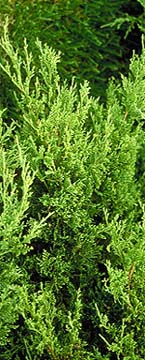x Cupressocyparis leylandii

Common: Leyland cypress
Family: Cupressaceae
Origin: Cross between Monterey cypress and Alaska cedar that originated in England in 1888. Six seedlings were discovered at Leighton Hall in the South of Wales. The two parent trees were growing on the estate and cross bred purely by accident. Since the Leyland cypress is not a naturally occurring tree, it has no natural range. It has been successfully grown in England, Australia, New Zealand, California, Louisiana, Mississippi, Alabama, Georgia, Florida and the Carolinas.
Light: Full sun; tolerates partial shade
Water: Moderate water. Drought tolerant, suitable for dry sites.
Temperature: Accepts wide variety of soil and climate. Can withstand temperatures to 0 degrees F
Most commonly used as Christmas trees. Can be used in shelter belts, hedges and landscape plantings. Growth rates of three feet per year are not uncommon. Ultimate height of tree can be as much as 100 feet, and it can do this for 60 years.
Foliage varies from one cultivar to the next. Generally, arranged in irregularly flat planes with dark green to gray color. Shoots branch repeatedly, and have a contrasting mahogany color except at tips. Bark has skin-like texture and is quite delicate. Texture of foliage is feathery and soft.
Should be planted in spring and kept well watered. Prune for first 2 or 3 years to allow root system time to develop. Trees could blow over due to rapid top growth and poor root development. Once established, trees can withstand wind, salt spray, drought, or hot or cold temperatures. Unlike most Christmas tree species, Leylands have no noticeable aroma. A leyland cypress, located on Cady Mall between Cowden Family Resources and Anthropology on the Arizona State Univesrity Campus, was planted on Arbor Day 1992.